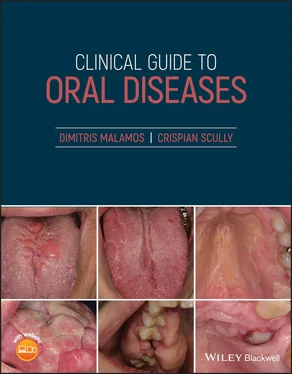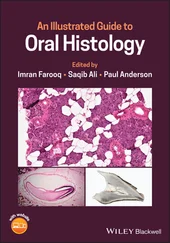Q3Which is/or are the main component(s) of fish malodor?
1 Ketones
2 Cholines
3 Methylamines
4 Acetone
5 Carbon dioxide
Answers:
1 No
2 No
3 Methylamines (mono, di, or tri) are considered as the major components of uremic toxins which are poorly removed with dialysis and play an important role in the production of fish odor.
4 No
5 No
Comments: Acetone and other ketones are products of fatty metabolism in patients with uncontrolled diabetes where the metabolism of glucose is impaired due to low insulin synthesis. Carbon dioxide is the major gas component of exhaled air and altered in various conditions or diseases but has never been linked with fish odor.

Figure 4.4
CO: A 23‐year‐old man presented with painful gums and bad breath.
HPC: His gums had been sore over the last ten days and associated with sialorrhea, metallic taste and bad breath.
PMH: This man had no serious medical problems, but his diet was inadequate and poor in proteins and fresh vegetables/fruits. He had lost his job last year and since then started to smoke more than 30 cigarettes daily.
OE: Erythematous gingivae with necrotic interdental papillae covered with whitish slough ( Figure 4.4). The gingivae were sore on probing and associated with sialorrhea, metallic taste and bad fecal breath. No other lesions were found in his mouth and other mucosae apart from a mild cervical (sub‐mental/maxillary) lymphadenitis.
Q1What is the cause of his bad breath?
1 Smoking
2 Chronic gingivitis
3 Acute necrotizing gingivitis
4 Malnutrition
5 Plasma cell gingivitis
Answers:
1 No
2 No
3 Acute necrotizing gingivitis is the cause of this condition, and is characterized by painful gums and inter‐dental papillae necrosis, both being associated with metallic taste and halitosis.
4 No
5 No
Comments: Oral malodor in young patients can be chronic or acute and seems to be related to local causes rather than systemic diseases. Among the local causes, oral infections and particularly of gingivae (gingivitis) and throat (pharyngitis); neglected mouth due to poor OH or bad habits like smoking, drinking and excessive diet are included. Some but not all the types of gingivitis have been associated with halitosis. Plasma cell gingivitis is characterized by accumulation of mature plasma cells in the free and attached gingivae, but is not associated with interdental necrosis or halitosis. Chronic gingivitis and smoking are often associated with chronic and not with acute halitosis as seen in this man; therefore are easily excluded. Malnutrition causes degradation of fat and release of ketones which are responsible for halitosis as long as the malnutrition lasts. His poor diet was recorded since the day of his job loss and is therefore is not a recent cause of halitosis.
Q2Which other conditions are associated with this gingival condition?
1 Diabetes, mild
2 Drug (heroin) addiction
3 HIV‐AIDS +ve
4 Vitamin deficiency
5 Respiratory diseases
Answers:
1 No
2 Patients addicted to heroin and other drugs have neglected oral hygiene, which is the main predisposition factor for the development of acute necrotizing gingivitis (ANG).
3 Immunodeficiencies caused by HIV viruses are often associated with a number of oral conditions including ANG, especially when the number of circulated CD4 lymphocyte count is lower than 200 cells/μL in their bloods.
4 Deficiency of various vitamins, especially B12 and C due to malnutrition seems to play an important role in ANG and other periodontal diseases by affecting DNA synthesis, cellular maturation and immunity.
5 No
Comments: Although smoking is a causative factor for both respiratory and periodontal diseases including ANG, ANG tends to appear among younger patients with poor oral hygiene or uncontrolled severe diabetes mellitus or with psychological stress and immune‐suppression. Chronic respiratory diseases affect older patients, are progressive and can jeopardize the patient's life but not provoke the development of this type of gingivitis.
Q3The microbiota pathogens of ANUG are:
1 Treponema spp.
2 Fusobacterium spp.
3 Selenomonas spp.
4 Streptococcus viridans
5 Lactobacillus acidophilus
Answers:
1 Treponema species are a group of spiral‐shaped bacteria that play a role in the pathogenesis of several diseases including syphilis (Trep. pallidum); periodontal and pulp diseases (Trep. denticole and Trep. lecithinolyticum).
2 Fusobacteria are anaerobic Gram –ve, non‐spurring, rod‐shaped bacilli, inhabitants of the oropharynx which cause several human diseases such as ANG and other periodontal diseases, skin atypical ulcerations and thrombophlebitis (Lemierre syndrome).
3 Selenomonas are anaerobic, Gram –ve, curved or crescent‐shaped rods that are isolated mainly from human oral cavity and play a crucial role in ANUG and other periodontal diseases.
4 No
5 No
Comments: Streptococcus viridans belong to a large group of Gram +ve bacteria that are isolated within the oral cavity and are mainly related to caries and not to periodontal diseases. Lactobacillus acidophilus is also a Gram +ve bacterium, but is part of the vaginal microbiota and does not play a role in the pathogenesis of ANUG.

Figure 4.5
CO: A 46‐year‐old man presented complaining of bad smell and breath over the last one and a half years.
HPC: According to the patient, his bad breath was first noticed during the period of his divorce, and became more severe during the last six months. His halitosis was constant during the day, easily noticed by him but not by his close relatives. At the same time, body odor problems were reported. Both complaints gave him serious concerns about meeting with other people at his job.
PMH: He had no serious medical problems apart from being carcinophobic, as he lost his best friend from a lung carcinoma five years ago. He was not under any medicine uptake and never a smoker or drinker.
OE: Physical examination revealed a healthy middle‐aged man with no obvious respiratory or gastroenterology problems. His mouth was in a good condition, with a complete dentition having a few fillings but no caries, healthy gingivae and absence of serious oral diseases ( Figure 4.5). Breathing his exhaled air from his mouth by closing his nose did not reveal bad breath. Smelling common odors did not reveal any disturbances.
Q1What was the cause of the patient's halitosis?
1 Early morning halitosis
2 Halitophobia
3 Smoking
4 Drug‐induced
5 Inadequate oral hygiene
Answers:
1 No
2 The fear of having bad breath (halitophobia) was the cause, despite that no one else could notice it. This halitosis is present all day, slightly improved during tooth‐brushing or eating chewing‐gum, causing the patient to brush his teeth and chewing‐gum many times during the day.
3 No
4 No
5 No
Comments: All the other causes of bad breath are easily detected by the people close to the patient, but this did not happen in this case. The early morning halitosis appears in healthy patients only in early mornings, but disappears with teeth brushing or eating breakfast. The absence of smoking or drug use together with the patient's good oral hygiene confirms the fear of non‐existing halitosis.
Читать дальше














